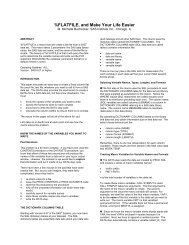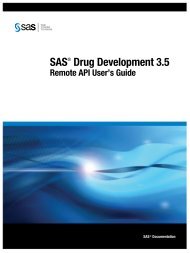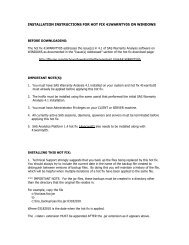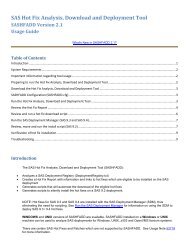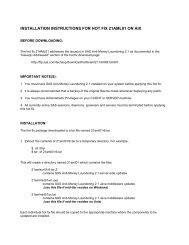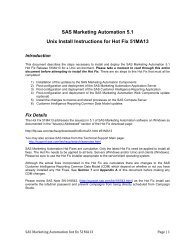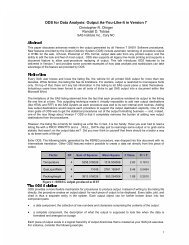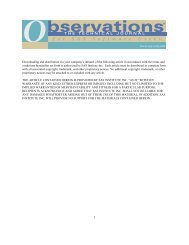SAS 9.3 Web Applications: Clustering - Index of - SAS
SAS 9.3 Web Applications: Clustering - Index of - SAS
SAS 9.3 Web Applications: Clustering - Index of - SAS
Create successful ePaper yourself
Turn your PDF publications into a flip-book with our unique Google optimized e-Paper software.
Configure JVM Options<br />
Each server instance inherits the JVM configuration from the <strong>SAS</strong>ServerTemplate.<br />
Some JVM options must be modified for each server instance. The<br />
sas.auto.publish.port JVM option must be modified to match the HTTP port for the<br />
server instance. Follow these steps:<br />
1 Select <strong>Web</strong>Sphere application servers, and then click the link for the server<br />
instance.<br />
2 Click Ports and make a note <strong>of</strong> the value for WC_defaulthost.<br />
3 Select Java and Process Management � Process Definition.<br />
4 Select Java Virtual Machine from the right panel <strong>of</strong> the <strong>Web</strong> page.<br />
5 In the Generic JVM arguments field, change the following values to the value<br />
for WC_defaulthost:<br />
n -Dsas.auto.publish.port<br />
n -Dsas.scs.port<br />
n -Dsas.scs.host<br />
Set the -Dsas.scs.port and -Dsas.scs.host JVM options to use the <strong>SAS</strong> Content<br />
Server instance that you selected in “Reconfigure the <strong>SAS</strong> Content Server<br />
Repository” on page 7.<br />
6 Add the following JVM options:<br />
-Dsas.appserver.instance.id=<strong>SAS</strong>Server2<br />
-Dsas.wrs.keyUserActionLog.path=<br />
/opt/<strong>SAS</strong>/Config/Lev1/<strong>Web</strong>/Logs/<strong>SAS</strong>Server2<br />
Also add this parameter to each server instance, using the appropriate server<br />
instance ID value. This value is used by <strong>SAS</strong> Content Server and in logging.<br />
7 Click OK and then save the changes to the master configuration.<br />
Configure the Cookie Name<br />
Configure the Cookie Name 47<br />
The <strong>SAS</strong> Information Delivery Portal, <strong>SAS</strong> BI Portlets, and <strong>SAS</strong> JSR168 Remote<br />
Portlets <strong>Web</strong> applications use the cookie name JSESSIONID<strong>SAS</strong>Server1. This is<br />
the default cookie name that the <strong>SAS</strong> Deployment Wizard configures for<br />
<strong>SAS</strong>Server1. In order to provide session affinity for the <strong>SAS</strong> <strong>Web</strong> applications, this<br />
cookie name must not be changed for the <strong>Web</strong> application server instances that<br />
serve those three <strong>Web</strong> applications. However, for the stand-alone server, you must<br />
change the cookie name to a different value to preserve session affinity on the<br />
stand-alone server. <strong>SAS</strong> recommends changing the value to <strong>SAS</strong>StandAlone. Follow<br />
these steps for the stand-alone server instance:<br />
1 Select <strong>Web</strong>Sphere application servers, and then click <strong>SAS</strong>Server1.





